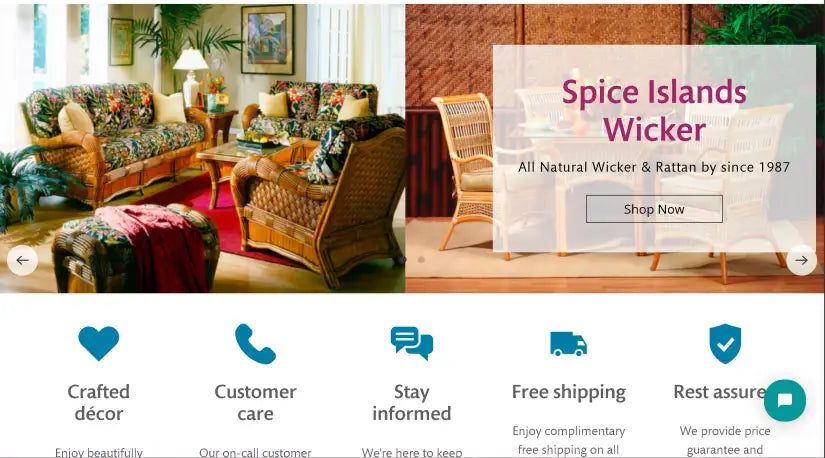Why Natural Rattan Furniture Remains the Designer's Choice
Natural rattan furniture offers best versatility, blending coastal charm with modern sophistication. Whether you're designing a breezy sunroom or adding warmth to a minimalist living room, rattan's unique properties bridge comfort and style.
Key Benefits of Natural Rattan Furniture:
- Durability: Solid-core vine construction supports up to 300+ lbs.
- Sustainability: A fast-growing palm that regenerates in 5-7 years.
- Versatility: Complements boho, coastal, Scandinavian, and modern styles.
- Craftsmanship: Hand-woven by skilled artisans, primarily in Indonesia.
- Indoor Focus: Best suited for covered spaces like sunrooms and living areas.
- Timeless Appeal: Danish design heritage creates sculptural, lasting pieces.
The journey from a Southeast Asian climbing palm to a finished furniture piece involves generations of craftsmanship. Unlike hollow bamboo, rattan is a solid material, making it highly bendable and durable enough to last for generations. From ornate Victorian pieces to today's clean-lined Scandinavian designs, rattan continues to evolve while maintaining its essential appeal.
I'm Nino Russo Alesi of Rattan Imports. My Italian heritage taught me to appreciate the art of curating beautiful moments at home. For years, I've connected designers and homeowners with authentic, handcrafted pieces that bring warmth and character to any space.
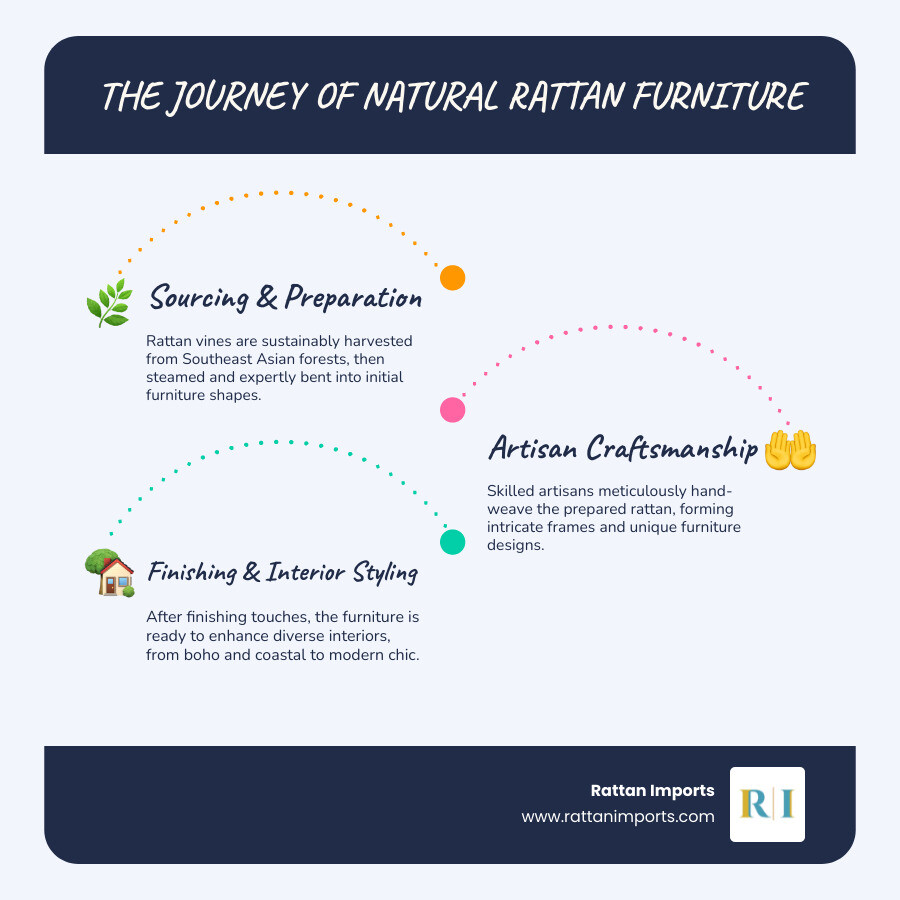
The Enduring Allure of Natural Rattan Furniture
There's something magical about the smooth, woven surface of a beautifully crafted rattan chair. When we talk about natural rattan furniture, we're celebrating pieces made from one of nature's most remarkable materials.
What is Rattan?
Rattan is a climbing palm native to the rainforests of Southeast Asia, particularly Indonesia. Unlike hollow bamboo, rattan has a solid core material, which gives it incredible strength and flexibility. When heated, this solid core becomes bendable, allowing artisans to shape it into the gorgeous curves we love. The outer skin is peeled for delicate weaving, while the inner core forms the sturdy frame of chairs and tables.
What is Wicker?
Many people confuse rattan with wicker, but wicker isn't a material—it's a weaving technique. Furniture can be called wicker whether it's made from rattan, willow, bamboo, or even synthetic materials. When you see natural rattan furniture with a classic woven look, you're seeing rattan material crafted using a wicker weave.
The Unique Benefits of Choosing Natural Rattan Furniture
Why is natural rattan furniture such a smart choice?
First, it's a sustainable material. Rattan regenerates in just 5-7 years and helps preserve forests because it needs existing trees to climb. Second, its handcrafted appeal means each piece is a unique work of art, carrying the touch of skilled artisans. The unique textures of natural rattan add instant warmth and character that synthetic materials can't replicate. It also helps with enhancing indoor air quality as it doesn't release harmful chemicals. Finally, with proper care, these pieces offer incredible long-term value, becoming cherished family heirlooms.
Rattan vs. Wicker: Clearing the Confusion
Here's a simple comparison:
| Feature | Rattan (the Material) | Wicker (the Weaving Method) |
|---|---|---|
| Definition | A solid, vine-like climbing palm | A technique of weaving pliable materials into furniture |
| Origin | Primarily Southeast Asia (especially Indonesia) | Ancient weaving method used worldwide |
| Properties | Strong, flexible, durable solid core that bends beautifully when heated | Creates breathable, lightweight designs with intricate patterns |
| Common Uses | Furniture frames, structural components, and decorative weaving | The finished woven product using various materials |
Understanding this difference helps you make better choices. For a deeper dive, check out our guide, "About Wicker and Rattan: Casual Furniture from Rattan Imports".
The beauty of natural rattan furniture lies in its combination of strength, sustainability, and timeless style. Ready to explore how it can transform your space? Our "Practical Guide to Choosing Rattan Living Room Furniture" is packed with helpful insights.
From Vine to Vogue: The Craftsmanship and Evolution of Rattan
The change of natural rattan furniture from a wild jungle vine to stunning home décor is a journey of ancient traditions and modern design.
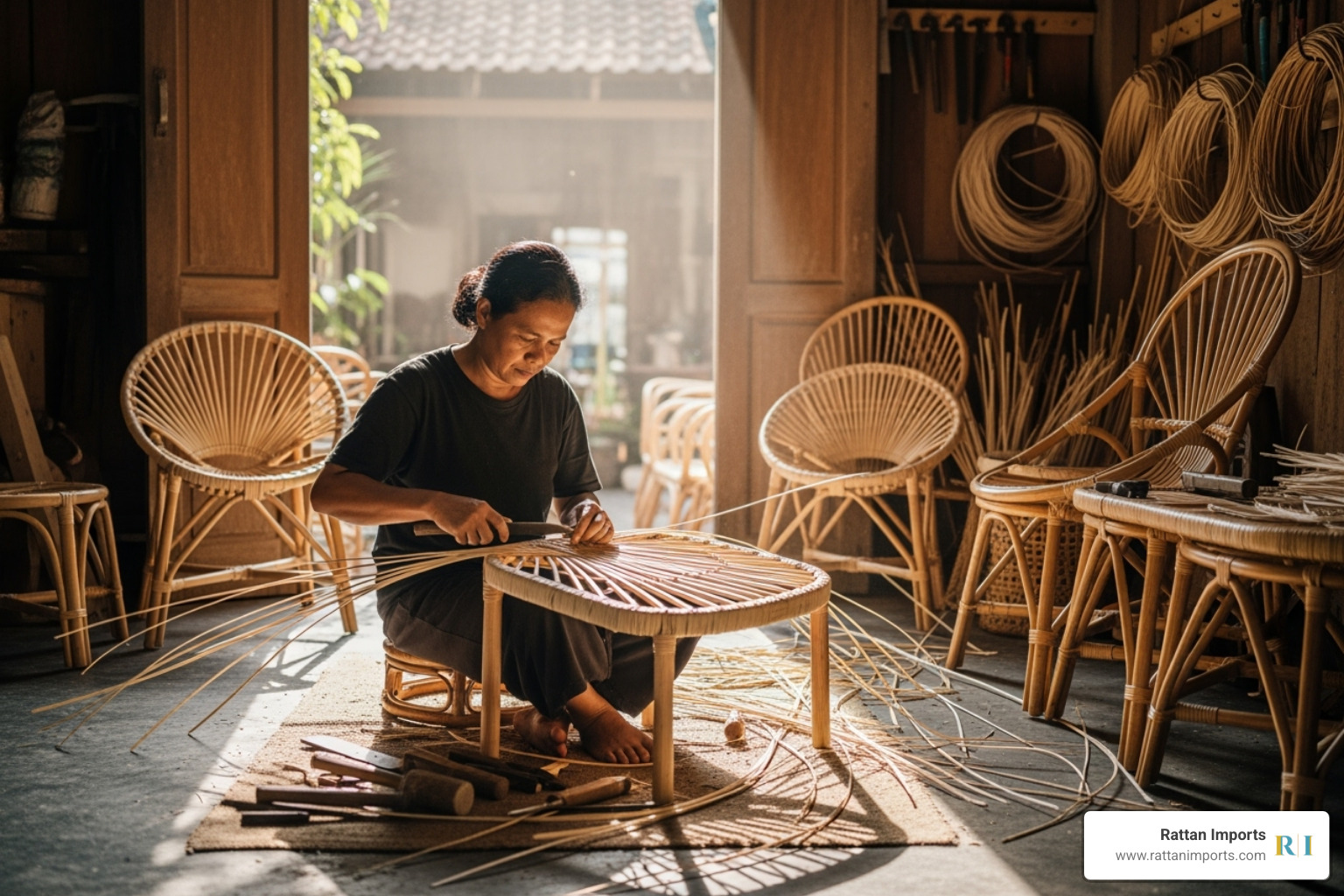
Sourcing Rattan
The story begins in Southeast Asian rainforests, with Indonesia as the world's premier rattan source. Local communities use sustainable harvesting practices that help preserve forests. Since the vines regrow after being cut and depend on existing trees, harvesting provides an economic incentive to protect the ecosystem.
The Manufacturing Process
Creating natural rattan furniture is a multi-step process honed over generations.
- Steaming and bending: Steam softens the solid rattan poles, making the strong material pliable enough for artisans to bend into graceful curves.
- Frame construction: The shaped poles are joined using traditional techniques to create strong foundations that can support 300 pounds or more.
- Weaving by hand: Thin rattan strands are carefully woven around the frame in traditional patterns.
- Finishing touches: Sanding, staining, and lacquering protect the rattan and improve its natural beauty. Some specialty finishes can take hours to apply by hand.
A Journey Through Time: The History of Rattan Design
Rattan's design evolution reflects changing cultural tastes. It entered American homes in the 1840s, leading to the Victorian era's ornate designs with intricate scrollwork. The mid-20th century brought a design revolution with mid-century modern icons. Designers like Arne Jacobsen and Nanna & Jørgen Ditzel acceptd rattan's sculptural potential, creating clean, artistic forms. The Danish design influence was particularly significant, introducing principles of simplicity, functionality, and lasting beauty that continue to shape rattan furniture today.
Current Trends in Natural Rattan Furniture
Today's natural rattan furniture honors tradition while fitting modern lifestyles.
- Minimalism and clean lines are popular, letting the material's natural texture shine.
- Blending with modern materials like metal and glass creates sophisticated, contemporary pieces.
- Sculptural forms are a major trend, with designers creating furniture that doubles as art.
- Modern headboard designs exemplify the trend toward airy and natural aesthetics.
- Painted and colored rattan offers personalization, from classic whites to bold accent colors. Our guide on choosing the best paint colors can help you find the perfect shade.
Styling Your Space: Integrating Rattan into Any Decor
One of the best qualities of natural rattan furniture is its ability to adapt to any personal style, from free-spirited bohemian to crisp modern minimalism.
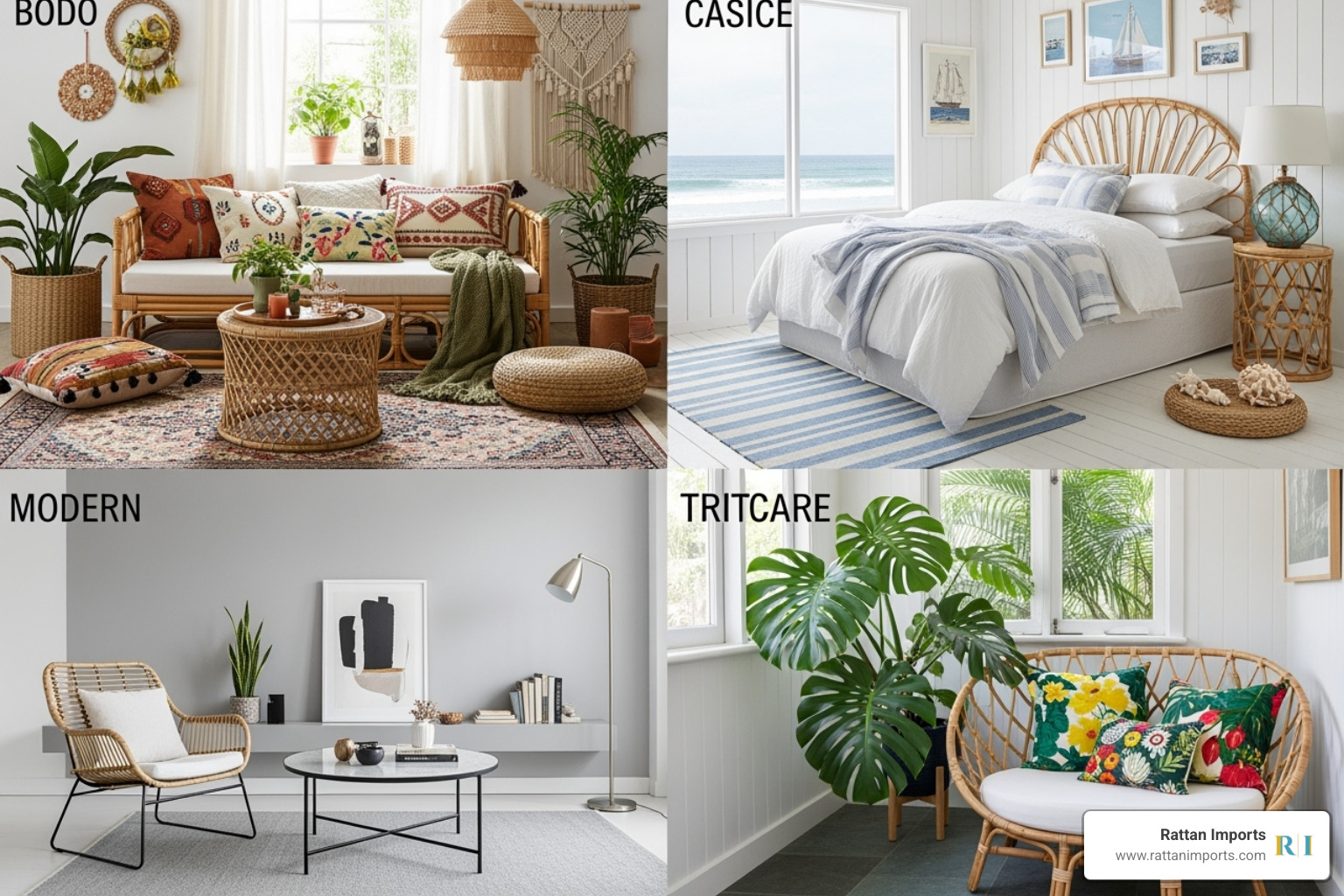
Versatility is Key
Rattan's natural honey tones act as a neutral backdrop, complementing both bold and soft color palettes. It doesn't compete with your existing decor—it improves it by adding organic warmth and texture. The intricate woven patterns create visual depth that flat surfaces lack, making any room feel more like home. You can go bold with a statement piece like a stunning peacock chair or add subtle accents like a side table or woven mirror.
A World of Styles
- Bohemian (Boho): Rattan and boho are a perfect match. Peacock chairs and layered textures create the collected-over-time feeling that defines this style.
- Coastal and Tropical: Rattan's island origins make it a natural fit for breezy, vacation-inspired spaces. Our guide, "Bali Furniture: Crafting Your Dream Space with Island Flair," offers more inspiration.
- Scandinavian (Danish): This style focuses on clean lines and functionality. Rattan pieces are simple, with minimal ornamentation but maximum impact.
- Modern and Minimalist: These spaces accept rattan's sculptural qualities to soften hard edges while maintaining a sophisticated look. Our collection of Modern Rattan Dining Chairs demonstrates this balance.
Rattan Furniture for Every Room
Natural rattan furniture has a place in every corner of your home.
- Living Room: Add welcoming sofas and loveseats, artistic armchairs and accent chairs, or functional coffee and end tables.
- Dining Room: Create a special atmosphere with complete dining sets or refresh your existing table with individual dining chairs.
- Bedroom: Turn your bedroom into a sanctuary with peaceful bedroom sets, focal-point headboards and beds, or practical dressers and nightstands.
Investing in Quality: A Buyer's Guide to Rattan
When you invest in quality natural rattan furniture, you're bringing home generations of craftsmanship, sustainable materials, and timeless style. Knowing what to look for ensures your furniture will serve your family for years to come.
Indonesian Craftsmanship & Danish Design
Indonesia is where the magic happens. Artisans pass down techniques through generations, blending local materials with cultural influences. When this is combined with Danish design principles—clean lines, functional elegance, and ergonomic comfort—the result is furniture that is both beautiful and incredibly durable.
What to Look For
Knowing what separates great rattan from mediocre pieces is key. Here's a quick guide.
Identifying High-Quality Rattan Furniture
- Check the Frame: It should be made of solid rattan poles. Give the piece a gentle shake; it shouldn't wobble or creak. Joints should be secure and tightly bound.
- Examine the Weave: Look for tight and consistent weaving with no loose ends or gaps. Quality rattan feels smooth, with no splintering.
- Feel the Finish: A proper finish should be smooth and even, protecting the rattan without feeling sticky or rough.
- Weight and Sturdiness: Well-made natural rattan furniture feels solid and stable. Most quality pieces can easily support up to 300 lbs or more.
Sourcing and Price Points
Understanding pricing helps you make a smart decision. Indonesian manufacturing offers advantages like generational craftsmanship and access to premium rattan.
Price ranges for natural rattan furniture reflect the quality. Entry-level pieces may use thinner rattan, while mid-range options offer a great balance of complex weaves and better finishing. High-end pieces showcase exceptional craftsmanship, unique designs, and premium materials. Cost is influenced by the grade of rattan, complexity of the design, the manufacturer's reputation, and special finishing processes.
At Rattan Imports, we focus on offering pieces that meet these high-quality standards. Explore our curated collections to experience the difference that quality craftsmanship makes.
Care and Longevity: Keeping Your Rattan Looking Its Best
Proper care for your natural rattan furniture is simple and ensures it will stay beautiful for decades. Rattan is a natural material that just asks for the right environment to thrive.
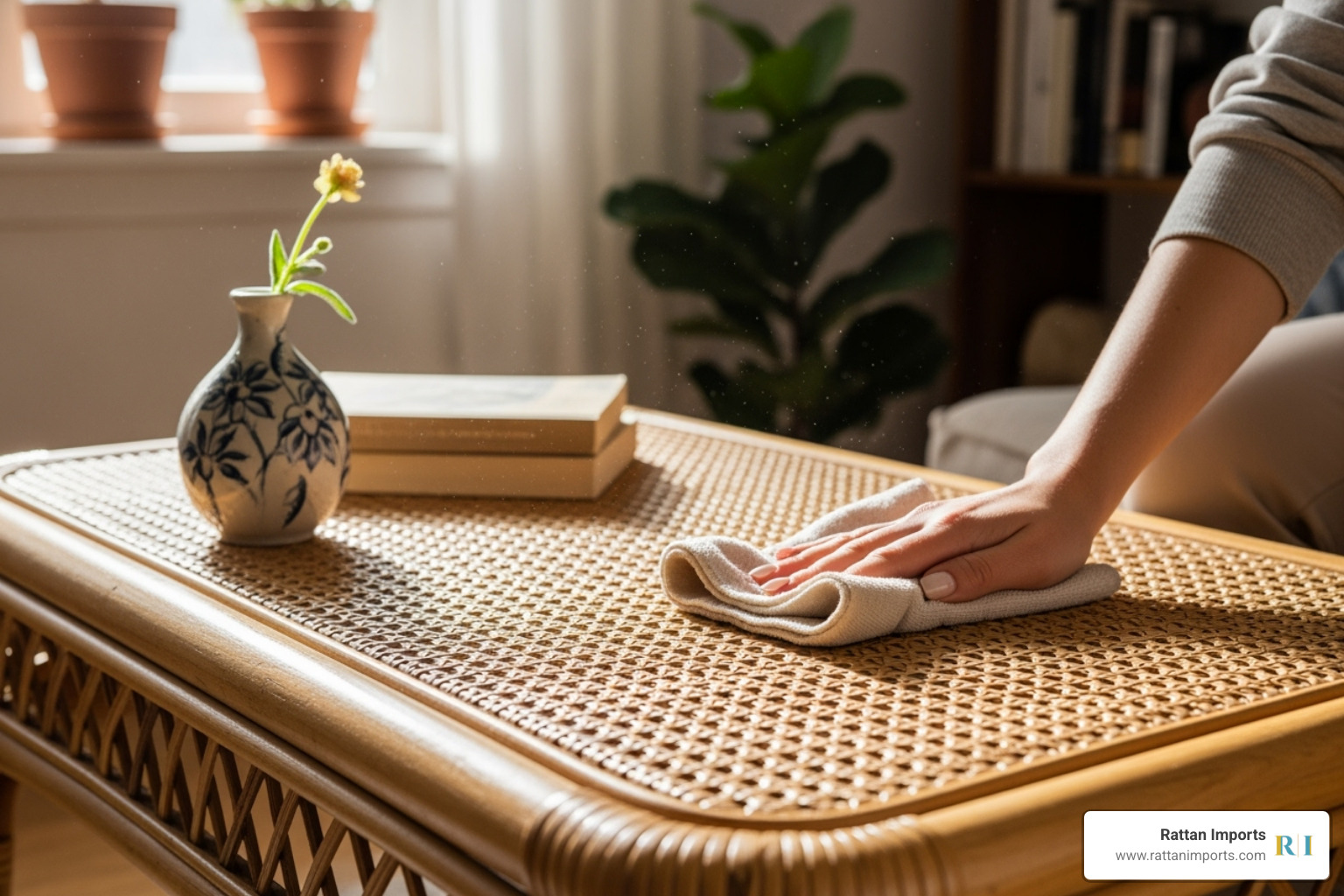
Indoor vs. Outdoor Use
The most important rule for natural rattan furniture is to keep it indoors or in well-protected covered spaces. It was not designed to battle the elements. Direct sunlight can make the fibers brittle and faded, while rain and humidity can cause swelling, mold, and discoloration. A few seasons of exposure can permanently damage the material.
Your rattan pieces will be perfectly happy in porches with deep overhangs, sunrooms, or covered verandas. For fully exposed outdoor areas, consider all-weather alternatives made from synthetic resin over aluminum frames. Explore our guide, "All-Weather Wicker Dining Furniture for Every Season," for durable options.
Your Cleaning and Maintenance Routine
Keeping natural rattan furniture clean is straightforward.
- Regular Dusting: Once a week, use a soft cloth, feather duster, or vacuum brush attachment to remove dust.
- Deep Cleaning: Monthly, wipe furniture with a microfiber cloth lightly dampened with a solution of mild soap and water. Dry each area as you go.
- Spills and Stains: Blot spills immediately with a clean, dry cloth. Never rub. For stubborn spots, use the mild soap solution and dry thoroughly.
- Mold or Mildew: If caught early, clean the area with a 50/50 solution of white vinegar and water, then allow it to dry completely in a well-ventilated area away from direct sun. For more tips, you can browse community tips on cleaning rattan.
- Minor Repairs: Small breaks can be fixed with wood glue. For larger issues, professional help is recommended. Our guide, "How to Expertly Repair Rattan Furniture," can walk you through more complex fixes.
Frequently Asked Questions about Natural Rattan Furniture
Here are answers to the most common questions we receive about natural rattan furniture.
How durable is rattan furniture?
Rattan is incredibly durable. Unlike hollow bamboo, rattan is a solid-core vine, making it both strong and flexible. High-quality natural rattan furniture is built on sturdy frames that can typically sustain weights up to 300 lbs or more. With proper indoor care, your rattan furniture can last for generations and become a family heirloom.
Is rattan an environmentally friendly choice?
Yes, it's a genuinely sustainable choice. Rattan is a fast-growing climbing palm that regenerates in just 5-7 years, much faster than hardwoods. Furthermore, rattan harvesting helps preserve rainforests. Because it needs existing trees to grow, it gives local communities an economic reason to protect their forests rather than clear-cutting them.
What is the main advantage of Danish design in rattan furniture?
The main advantage is the blend of simplicity, functionality, and exceptional craftsmanship. Danish design creates timeless pieces with clean lines and ergonomic comfort, so they are as comfortable as they are beautiful. This design philosophy results in sculptural, lasting natural rattan furniture that feels both classic and contemporary, making it a smart long-term investment for your home.
Conclusion
From Indonesian rainforests to your living room, natural rattan furniture tells a story of craftsmanship, sustainability, and timeless design. Its strength, eco-friendly origins, and versatility make it a remarkable choice for any home, fitting seamlessly into boho, coastal, or modern minimalist spaces.
When you invest in quality rattan, you're bringing home generations of knowledge. The Danish design influence ensures each piece is a perfect marriage of form and function—sculptural, comfortable, and built to last. Proper care rewards you with enduring beauty that grows with time.
At Rattan Imports, we connect you with these authentic, handcrafted treasures. We believe your home deserves furniture that reflects your values, whether that's sustainability, craftsmanship, or timeless style.
Your home is your sanctuary. With free shipping across the U.S. mainland and our price guarantee, we make it easy to find the perfect piece.
Ready to transform your space? Find the perfect rattan pieces for your home today!

